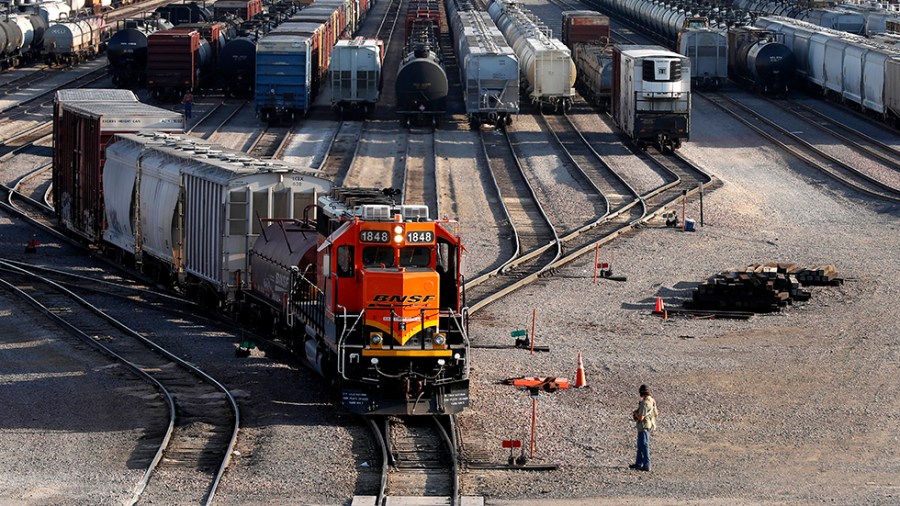Freight railroads are failing to keep pace with consumer demand, putting additional strain on the nation’s supply chains that have been plagued by trucker shortages and congested ports, among other challenges.
Trade groups representing energy and agricultural producers say that rail service disruptions are delaying shipments of raw materials and driving up prices that consumers pay for food, gas and other products.
They chiefly blame railroads for understaffing their operations. Over the last six years, the leading freight carriers laid off 45,000 employees, or nearly 30 percent of their combined workforce, according to the Surface Transportation Board. Most of the layoffs came before the pandemic, which ushered in a huge demand for shipped items.
“The most important reason why the railroad leg of the supply chain failed over the last year and a half is the fact that they did not have the workforce or the equipment to be able to deal with the demand for goods,” said Greg Regan, president of the AFL-CIO’s Transportation Trades Department, which represents several railroad worker unions.
Freight rail giants have come under scrutiny from lawmakers and federal regulators over a series of recent service issues.
Nineteen senators penned a bipartisan letter to the Surface Transportation Board on Tuesday, urging its members to “examine all constructive options” to ensure the transportation of food and energy commodities. They warned that recent service issues forced energy companies to curtail production and prompted feed mills to temporarily shut down.
“If these problems persist into summer and fall, significant portions of the world’s breadbasket could be cut off from assisting those most in need, yielding waste rather than solutions,” wrote the lawmakers, led by Sens. Kevin Cramer (R-N.D.) and Tammy Baldwin (D-Wis.). “The same applies to the transport of critical energy supplies in high demand across the United States and the globe.”
The letter comes after the National Grain and Feed Association testified before the board that service disruptions cost the grain industry more than $100 million due to lost revenues and additional freight expenses in the first quarter of 2022.
“Depending on the market position of the grain industry participant, these extra transportation costs are either borne by the participant, reflected in the grain basis paid to the farmer or passed onto the consumer,” Mike Seyfert, the group’s president, told the board last month.
Shippers have described the leading freight carriers as “regional monopolies” that lack sufficient competition in their respective markets. The industry is dominated by four railroads: BNSF Railway, Union Pacific, Norfolk Southern and CSX Corp., all of which recently reported soaring profits.
The American Fuel and Petrochemical Manufacturers testified that service disruptions and lack of competition in the railroad industry worsen inflation, stating that transportation and distribution costs account for 11 percent of the price of gas at the pump.
“Being a ‘captive’ shipper amplifies the negative impacts of service disruptions, like those our members are currently experiencing,” the group said, noting that 75 percent of refiners are served by just one railroad. “To this end, service disruptions that elevate transportation costs not only impact our members but consumers.”
Consumer prices rose 8.3 percent over the past 12 months ending in April, nearing the fastest rate of inflation in four decades, according to the Labor Department. Fuel and food prices spiked in the U.S. and globally after Russia, a top energy supplier, invaded Ukraine, a major grain and cooking oil exporter.
Earlier this month, the Surface Transportation Board issued an order requiring freight carriers to report how they plan to improve their service as part of a larger effort to quickly improve rail capacity.
The big four railroads have defended their practices, stating that they couldn’t have known that demand for shipped goods would spike and noting that the tight labor market makes it difficult to attract new train conductors.
BNSF said that it has hired 400 new train workers as part of its plan to hire 3,000 employees this year. Norfolk Southern said that it has 930 active conductor trainees and plans to bring in more in the near future. The industry is offering hiring bonuses and incentive payments to move workers to parts of the rail network that are particularly short-staffed.
“Railroads are not immune to the broader challenges of the labor market, but the industry is confident in its plans to normalize the number of workers to a level consistent with demand,” Ted Greener, assistant vice president for public affairs at the Association of American Railroads, said in a statement. “Over time, this should help improve service.”
But as railroads push to hire more workers, they’re engaged in a long-running dispute with labor unions that say train conductors are overworked, fatigued and underpaid.
Regan said that harsh policies are pushing workers away from railroads. Hundreds of BNSF workers quit in recent months over a controversial attendance policy that docks employees for absences, including taking sick days in some cases. BNSF softened the policy last week, but workers say it is still problematic.
The National Mediation Board, an agency that works out railroad contract disputes, began a three-day negotiation session Tuesday between the leading freight carriers and 12 railroad labor unions.
The union coalition is asking the board to release the labor unions from mediation, a move that would give both sides the option to enter arbitration. If one of the two parties declines to do so, it would set the stage for railway workers to go on strike.
Both sides agree that a strike is highly unlikely, as the White House and Congress could step in to prevent the resulting economic calamity. But railroad unions see the negotiations as a potential pathway to their first contract in several years.
“If you want to actually improve the supply chain from a rail perspective, then getting a fair contract for workers is the most important thing you can do to achieve that,” Regan said.
